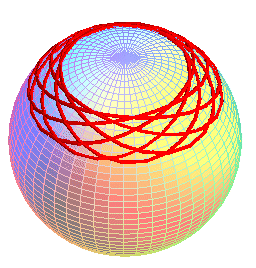



| next curve | previous curve | 2D curves | 3D curves | surfaces | fractals | polyhedra |
SPHERICAL CATENARY
 |
 |
 |
 |
| Curve studied by Bobillier in 1829 and Gudermann in 1846.
See: Paul Appell, cours de mecanique rationnelle, page 223 |
| Differential equation: First integral in cylindrical coordinates: hence: i.e., taking Note the tiny difference with the curve of the spherical pendulum, for which |
The spherical catenary is the equilibrium line of an inelastic flexible homogeneous infinitely thin massive wire included in a sphere, placed in a uniform gravitational field. Like any catenary, its center of gravity has the minimal altitude among all the curves with given length passing by two given points.
In the same way as for the curves of the spherical pendulum, we get the curves composed of a series of undulations joining in turns two parallels (obtained for the values where the polynomial P above cancels out), and rotated around Oz. The curve is either closed or dense in the area enclosed by the two parallels.
Model made with Povray by Alain Esculier
| next curve | previous curve | 2D curves | 3D curves | surfaces | fractals | polyhedra |
© Robert FERRÉOL 2018